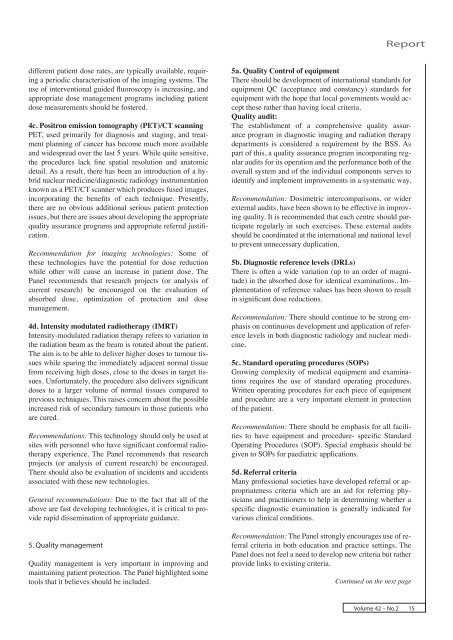ISRRT_August_2006
You also want an ePaper? Increase the reach of your titles
YUMPU automatically turns print PDFs into web optimized ePapers that Google loves.
Report<br />
different patient dose rates, are typically available, requiring<br />
a periodic characterisation of the imaging systems. The<br />
use of interventional guided fluoroscopy is increasing, and<br />
appropriate dose management programs including patient<br />
dose measurements should be fostered.<br />
4c. Positron emission tomography (PET)/CT scanning<br />
PET, used primarily for diagnosis and staging, and treatment<br />
planning of cancer has become much more available<br />
and widespread over the last 5 years. While quite sensitive,<br />
the procedures lack fine spatial resolution and anatomic<br />
detail. As a result, there has been an introduction of a hybrid<br />
nuclear medicine/diagnostic radiology instrumentation<br />
known as a PET/CT scanner which produces fused images,<br />
incorporating the benefits of each technique. Presently,<br />
there are no obvious additional serious patient protection<br />
issues, but there are issues about developing the appropriate<br />
quality assurance programs and appropriate referral justification.<br />
Recommendation for imaging technologies: Some of<br />
these technologies have the potential for dose reduction<br />
while other will cause an increase in patient dose. The<br />
Panel recommends that research projects (or analysis of<br />
current research) be encouraged on the evaluation of<br />
absorbed dose, optimization of protection and dose<br />
management.<br />
4d. Intensity modulated radiotherapy (IMRT)<br />
Intensity-modulated radiation therapy refers to variation in<br />
the radiation beam as the beam is rotated about the patient.<br />
The aim is to be able to deliver higher doses to tumour tissues<br />
while sparing the immediately adjacent normal tissue<br />
from receiving high doses, close to the doses in target tissues.<br />
Unfortunately, the procedure also delivers significant<br />
doses to a larger volume of normal tissues compared to<br />
previous techniques. This raises concern about the possible<br />
increased risk of secondary tumours in those patients who<br />
are cured.<br />
Recommendations: This technology should only be used at<br />
sites with personnel who have significant conformal radiotherapy<br />
experience. The Panel recommends that research<br />
projects (or analysis of current research) be encouraged.<br />
There should also be evaluation of incidents and accidents<br />
associated with these new technologies.<br />
General recommendations: Due to the fact that all of the<br />
above are fast developing technologies, it is critical to provide<br />
rapid dissemination of appropriate guidance.<br />
5. Quality management<br />
Quality management is very important in improving and<br />
maintaining patient protection. The Panel highlighted some<br />
tools that it believes should be included.<br />
5a. Quality Control of equipment<br />
There should be development of international standards for<br />
equipment QC (acceptance and constancy) standards for<br />
equipment with the hope that local governments would accept<br />
these rather than having local criteria.<br />
Quality audit:<br />
The establishment of a comprehensive quality assurance<br />
program in diagnostic imaging and radiation therapy<br />
departments is considered a requirement by the BSS. As<br />
part of this, a quality assurance program incorporating regular<br />
audits for its operation and the performance both of the<br />
overall system and of the individual components serves to<br />
identify and implement improvements in a systematic way.<br />
Recommendation: Dosimetric intercomparisons, or wider<br />
external audits, have been shown to be effective in improving<br />
quality. It is recommended that each centre should participate<br />
regularly in such exercises. These external audits<br />
should be coordinated at the international and national level<br />
to prevent unnecessary duplication.<br />
5b. Diagnostic reference levels (DRLs)<br />
There is often a wide variation (up to an order of magnitude)<br />
in the absorbed dose for identical examinations.. Implementation<br />
of reference values has been shown to result<br />
in significant dose reductions.<br />
Recommendation: There should continue to be strong emphasis<br />
on continuous development and application of reference<br />
levels in both diagnostic radiology and nuclear medicine.<br />
5c. Standard operating procedures (SOPs)<br />
Growing complexity of medical equipment and examinations<br />
requires the use of standard operating procedures.<br />
Written operating procedures for each piece of equipment<br />
and procedure are a very important element in protection<br />
of the patient.<br />
Recommendation: There should be emphasis for all facilities<br />
to have equipment and procedure- specific Standard<br />
Operating Procedures (SOP). Special emphasis should be<br />
given to SOPs for paediatric applications.<br />
5d. Referral criteria<br />
Many professional societies have developed referral or appropriateness<br />
criteria which are an aid for referring physicians<br />
and practitioners to help in determining whether a<br />
specific diagnostic examination is generally indicated for<br />
various clinical conditions.<br />
Recommendation: The Panel strongly encourages use of referral<br />
criteria in both education and practice settings. The<br />
Panel does not feel a need to develop new criteria but rather<br />
provide links to existing criteria.<br />
Continued on the next page<br />
Volume 42 – No.2 15


















